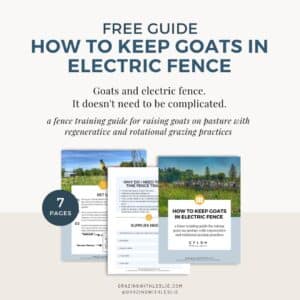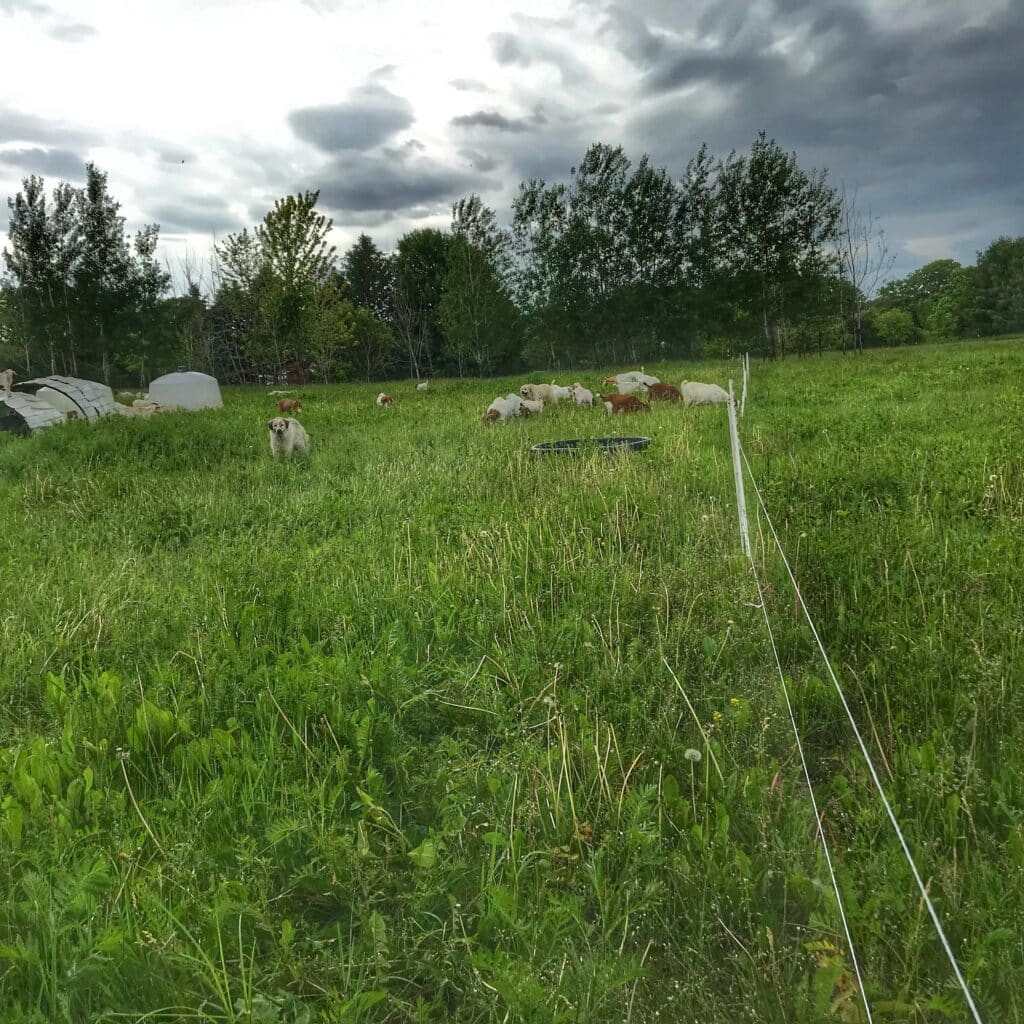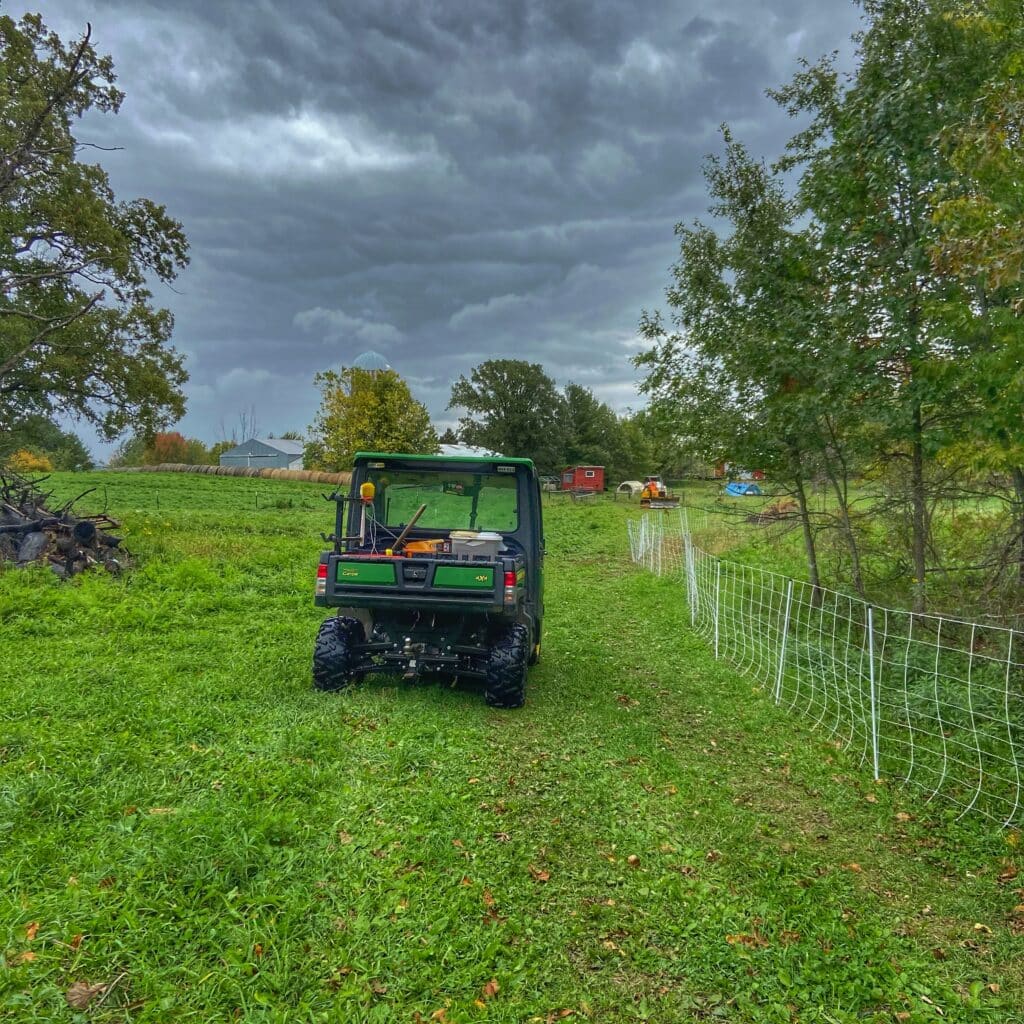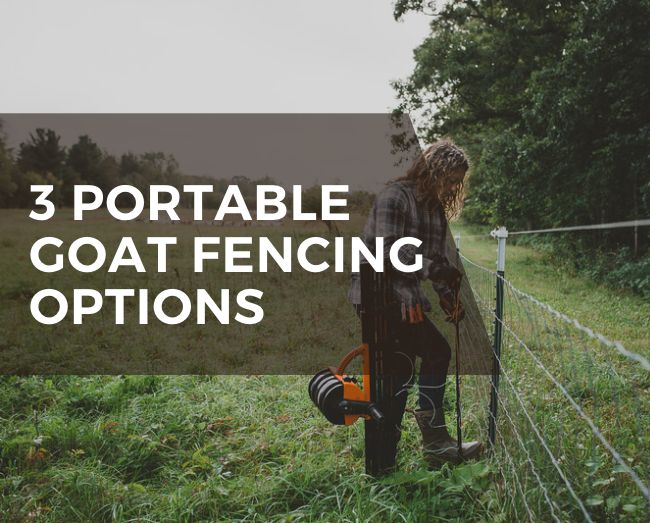Portable goat fencing paired with electric is an effective solution to keep goats in their fence, a lower-cost option, and a way to practice regenerative agriculture with rotational grazing. This post will also cover the top 3 portable goat fencing options.
Table of contents
Benefits of portable electric fence
- Portable electric fence is very effective in keeping in livestock, especially goats and sheep. It can be intimidating at first thought, often deterring those raising goats from using electric fence. However, once you have a feel for how the fencing works, and you train your goats to respect the electric fence, it can be very effective. Learn more about how to do this with my free electric fence training guide for goats.
- Temporary fence is also a lower-cost option. Yes, you’ll need to purchase the portable goat fencing, but it is much more economical as compared to installing a permanent goat fence, which can be very expensive, a long wait for a professional fence installer, and time intensive process in you decide to DIY.
- Portable electric fence is an easy way to get started with regenerative agriculture practices since you can use it to set up paddocks for rotational grazing. Learn more about rotational grazing with goats in my on-demand online workshop.
Portable electric fencing options
There are three main portable electric fencing options for goats:
- Electric fence netting, also known as electronet: A plastic, mesh fence with spike posts, typically 50-160 feet in size. Multiple rolls can be used.
- Multistrand polywire with step in posts, usually set up with 2-3 strands for goats
- Smart Fence, an all-in-one-system with one reel, four strands of polywire with step in fence posts, about 300 feet in size. Multiple fences can be used together. (affiliate link, use CYLON for 10% off your entire order). Read my review of the Smart Fence here. I’ve been using this fence for almost 8 years before I started partnering with Gallagher.

Pros and cons of portable goat fencing options
Here are the pros and cons of portable electric fences for goats:
| Portable Goat Fence Characteristics | Electric Netting | Polywire with Step in Posts | Smart Fence |
| Ease of set up and take down | Slower, may have issues with tangling | Slower, working with individual reels and posts | Quicker |
| Ease of storage or transporting | More challenging since tangling can happen | More gear, including multiple reels and posts | Easier with an all-in-one system |
| Risk of goats getting out | Less risky since there’s more of a physical barrier | More open space with 1 to 3 strands of polywire | More open space with 4 strands of polywire |
| Predator protection | Less risky since there’s a larger physical barrier with the mesh fence | Greater opportunity for crawling under the bottom wire | Greater opportunity for crawling under the bottom wire |
| Works with guard dogs | Less risky since there’s a larger physical barrier | Greater opportunity for crawling under the bottom wire | Greater opportunity for crawling under the bottom wire |
| Issues for young kids | Goat kids may risk getting tangled in the net | Goat kids can crawl under the bottom wire | Goat kids can crawl under the bottom wire |
| Estimated cost for 150 feet* | $0.99/foot | $0.49/foot + 3 reels per fence at $279.96 | $1.88/foot |
* Electric goat fence costs based on February 2023 pricing online with Gallagher Smart Fence 2, Premier 1 Supplies ElectroStop 10/42/12, single spike, and Gallagher: Turbo Wire (1640 ft roll), 10 HD Treadin Posts, and 3 standard reels.
Other equipment needed
When using portable electric fencing for goats you’ll also need other equipment beyond the fence itself:
- Electric fence charger or fence energizer
- Jumper cables or alligator cables
- Grounding rods
- Extra step in posts
- Fence checker



How to set up portable electric fence
Here’s how you’ll set up your temporary goat fencing:
Remove tall vegetation and brush
No matter the type of temporary goat fencing you choose you’ll still need to clear a path for the fence line. This may mean mowing the grass in your pasture or removing other vegetation with a brush hog or even a chainsaw. If you’re setting up portable goat fencing in a grassy pasture or hay field, you might be able to just beat a fence path down with the wheels of a four-wheeler or UTV.
Ideally, the level removed should be below your bottom wire or just at the bottom of the electric net fencing. This will help keep the fence properly energized, reducing any grounding issues and keeping the fence hot, ie. keeping the goats contained inside the fence.
Planning fence set up for padock size
You’ll want to take a look at your pasture, woods, or other areas where you’ll be grazing your goats, sheep, or other livesotck to figure out the best option for your paddocks and fence set up. This may need to be done on a regular basis as you set up a new goat fence for new paddocks.
The easiest approach is to create a series of “L” shapes with your fence. By using three fences you can create one square paddock where the goats will graze the pasture or woods. Then, be able to set up the next L shape fence to build the next paddock. This way you can easily move the goats into the next paddock without having them ever leave a fenced in area.
You’ll then take down the back fence and use it to create the next paddock and so on. This can be done with multiple portable fences depending on the sizes of your paddocks and available forage/feed sources for your goats.
Remember portable goat fencing is a temporary fence
Please note portable goat fencing is designed to be temporary! It is not intended to be permanent and should be moved fairly regularly to avoid grounding issues with the electric fence, and keep your goats contained with fresh pasture to graze, and also minimize parasite issues with your goats. P.S. always keep the fence on!
Where to purchase fencing for goats
My two favorite retails for goat and sheep fencing supplies are Premier 1 Supplies and Gallagher.
We’ve been using Gallagher products from the very start with our energizers and portable fencing. I’m proud to be a Gallagher partner and also share with you a 10% discount code – CYLON – on your entire order on the Gallagher NA website, for orders in the U.S. and Canada (affiliate link).
FAQs about portable fence
On our farm we use the portable fencing for rotational grazing. We are moving the fence every 1-3 days to a new paddock as a feed source for the goats. In short, grazing like this is a great for the animals since it’s helping reduce parasite issues, it encourages increased forage production in your pastures, and it’s good for soil health.
There are ways to use movable fence longer term, but you need to watch out for grounding issues with grass growth and make sure there’s enough pasture as a feed source for your goats. If they don’t have enough to eat they will find a way to get out of the fence to get food.

LEAVE A COMMENT
Comments